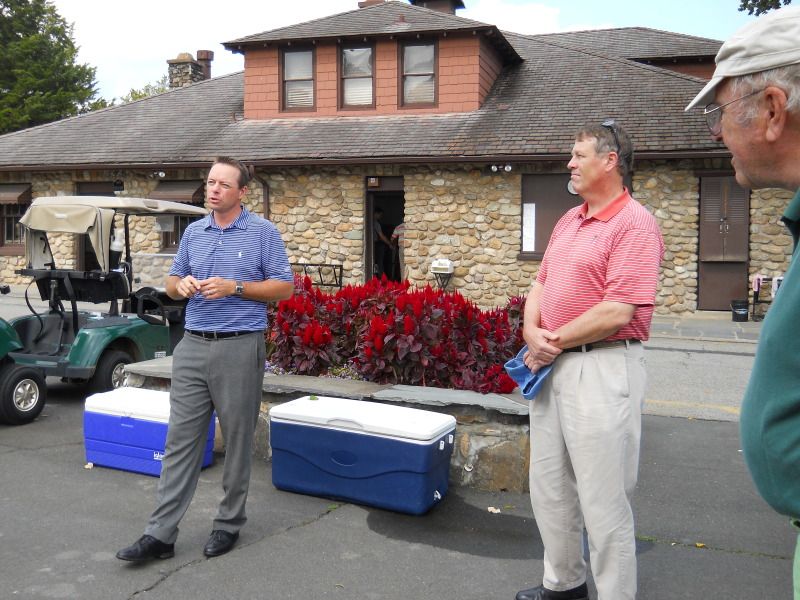
[Editor’s Note: The Architect’s Progress series gives golf fans an inside look at what a golf course architect actually does on the job from the ground up, following a golf course’s recovery and reclamation from the beginning of the restoration process, to the middle, then on to completion, analyzing not only the goals the course set for the project, but how well those goals were achieved. Part 1 of the story of Paramount Country Club is HERE.]
NEW CITY, NY – A truly great golf architect understands the breadth of his responsibility when taking on restoration work at a Golden Age golf course: He owes a duty to history as well. Architects from Robert Trent Jones, Jr. to Jim Engh (and many in between) believe that the first priority of a golf course architect is preservation.
“It’s like being a doctor,” Jones once said. “First, do no harm.” For an original design that generally means “preserve and utilize the naturally existing terrain.” For a Golden Age country club restoration it usually means “be faithful to the original design or intent.”
That’s the greatest success of Jim Urbina’s restoration work so far at Paramount Country Club. With roughly six holes left to finish, Urbina isn’t just polishing this formerly hidden gem to a high shine. He’s bringing back what he called “the hallmarks of Paramount” – excellent architectural strategies and angles which, when coupled with the course’s phenomenal routing, make it certain to rise in stature in the Pantheon of great Tillinghast courses nationwide. Urbina and course superintendent Brian Chapin’s work to the midway point is so good that the Tillinghast Association had a recent meeting and outing there to tour the changes thus far. And when such an august and knowledgeable body as that – the group charged with preserving and promoting Tillinghasts’s legacy – comes away unanimously impressed as they were last week, you know the club is doing things right.
A year ago the club’s stated mission was simple: restore the golf course as faithfully to Tillinghast’s original layout as possible and, where change was absolutely necessary, design something Tillie would have so that the new work blends seamlessly with the rest of the course.
Happily, the work Urbina and Chapin have done thus far at Paramount isn’t just a home run. It isn’t just a grand slam. It’s a tape measure blast into the upper deck with them rounding the bases to thunderous applause.
BACK TO THE FUTURE
A.W. Tillinghast did things at Paramount that he rarely did at his better known courses. Only on rare occasions would Tillie build skyline greens, (such as Alpine Country Club in New Jersey), center-line fairway bunkers, (the second hole at Ridgewood (Center course), and a small handful at S.F.G.C. or Brook Hollow in Texas) or markedly dramatic ascents uphill to a green perched on top of a mountain (15 at Bethpage). Yet he built all three of those rare-for-Tillinghast design features in the first six holes at Paramount. As such, Paramount could be considered an architectural collection of the Greatest Hits of A.W. Tillinghast. Only his quintessential design staple, the “Great Hazard” bunker, is absent from Paramount.
“What makes Paramount unique among Tillinghast courses is that it has much more elevation change than his other layouts – it’s not like Quaker Ridge or Winged Foot. It’s also built on a huge scale, like Bethpage Black, and the great positive about Paramount in that regard is that the routing takes full advantage of that terrain. It’s perfect. You climb to the top of the hill for the first hole and then wind your way down over the course of the next six, before finishing in what I call the Flats,” explained Urbina energetically.

Don’t be fooled by what Urbina calls “the Flats,” because they aren’t flat at all. The lovely par-3 ninth hole plays across a gorge to a green surrounded by turbulent bunkers. Players ascend another dramatic rise to reach the 14th green, then cascade back down at 15, while the 16th holes also winds down and back up before the course climaxes with Urbina’s faithful restoration of the “Reef Hole” Tillinghast describes in his book “The Course Beautiful.” All that turbulent terrain and wild elevation change give the course remarkable and memorable character.
“I think that because Tillie designed this course as a private club for one person, it would be much different than what he built at tournament venues like Winged Foot and Quaker Ridge or even a major club like San Francisco Golf Club,” Urbina continued. “He knew he wasn’t building Paramount for the greatest players in the country; instead it was a members’ course.”
Urbina went on to say that even so, the terrain was as good as almost any course Tillie designed. The enormous topography change of the first hole at Paramount is similar to the climb to the top of Bethpage Black’s iconic 15th hole, but also has the broad, expansive vista you would find perhaps at San Francisco Golf Club’s 16th hole, where you can see the ocean.
“When you’re on the first or sixth green at Paramount, you can see the high tor [called “the Palisade” by the locals] and the Hudson River valley. You won’t see that in New York City! Holes five and six play as well some of the best up and down holes at Winged Foot or Quaker Ridge.”
Indeed, they do. Five and six aren’t the only marked improvements. When we toured the course last year, Urbina and course superintendent Brian Chapin had finished restoring only those two holes. Now work has been completed on holes 1-6, 10-11, 15, 17, and 18, and it’s remarkable how many playing angles have been restored simply due to aggressive tree removal, green expansion, and wider mowing lines.
“When you take out the trees, it makes an enormous difference in the health of the turf,” said Chapin.
It’s also remarkable how much character as been restored to the golf course as a result. Urbina, who has lived for extended periods on a course-side cottage during the restoration noticed immediate improvements soon after he started work.
“The first thing I noticed was the remarkable transformation the mowing lines made. It took Paramount from a scripted narrowness to the broad expense that it could be, bringing back all kinds of playing angles that had vanished over time,” Urbina noted. “Mowing lines dictate the architecture, and the expansion changed the entire complexion of the golf course…and it’s the cheapest thing to do!”
Mowing lines and tree removal were just the beginning. Squaring off the green lines and making the fairway flow seamlessly into the green also transformed not only the look and feel of the course, but the playability. They also lowered the rough to a mere 1.5 inches and went with collarless greens and no buffer of rough around bunkers.
“We want to ball rolling into bunkers and bouncing all over,” explained Chapin
That was a bit of a happy accident – Brian and Jim got their signals mixed, but when Jim saw it, he loved the look and the way it played, so they kept it. The members like it too.
“It’s an old school feel, and it allows many options around the greens. We don’t just have a lob wedge in our hands, and we aren’t trying to gouge the ball out of a spinach patch,” said one member whose name we didn’t catch. But when he heard we were writing an article about the restoration he gleefully added, “You tell them we love it! It’s a whole new golf course. Every hole they finish is like getting another present on Christmas!”
Indeed, the club’s remarkable resurgence is noticeable all around the course. Your author’s favorite hole is the 590-yard, par-5 second hole that cascades downhill through a rugged chicane, twisting left then right between several newly restored fairway bunkers before emptying out smoothly into the green. But as our elusive member noted, there are new surprises at every turn. The back of the third green has a new area mowed as green that could even become a cheeky, puckish, but interesting new hole location.

The only other true par-5 on the course, 17, is also much improved. It has what Chapin called “the coolest green on the course” since the severe slope towards the greenside bunker makes for a great defense on a short par-5 and because you have to play almost twice as much break as you read due to both micro and macromovement.
THE NEW 18TH HOLE – THE REEF
One of the key elements of the restoration was to do something – anything! – to improve the former 18th hole, which was abysmal. A long and severely uphill hole played to a simple circle of a green fronted by a bunker, which in turn was fronted by another simple circle of fairway. It was a dreadful letdown and an eyesore to boot.
The club decided to build what Tillinghast called a “Reef Hole” a par-3 template your author believes is a derivative work of other, similar par-3s, only with additional strategic elements added by Tillinghast to create playing angles.
“The strategy of the Reef hole allows for options short and long of the bunker, which is like the reef guarding the landmass. The ridgeline, which is at a 45-degree angle to the line of play, protects the green as well,” explained Urbina. The ridge allows for golfers to play to different sectors of the green if you challenge the reef.
“What we built at 18 is an interpretation,” Urbina continued. “We had aerial photos to work with and Tillie’s drawings in his books.”
“We also went and took a look at Newport and the 12th at Bethpage Yellow,” added Chapin. “Jim nailed it; he got the angles dead on.”
So how did the club do in their stated goal of improving the hole? Pretty well, actually. It is, indeed, an enormous improvement over what was there before. Now there is some strategy, now the hole is attractive, now the hole fits the rest of the course, now the round doesn’t end like a car crashing into a brick wall, now they have a true museum piece/conversation piece, and that’s a huge plus.
Is it a hole that “assumes additional importance because golfers will begin anticipating it early in the round” as Phil Young put it in his chapbook of the Club? I can’t go quite that far. Young, understandably, may overstate the case a bit: it’s a really nice hole, but it’s no 17 at Sawgrass or nine at Yale because it won’t utterly sink your scorecard like a pint sized-Titanic. The anticipation of it is more an architectural appreciation. Your day does not revolve around worrying about that hole, and it is not the centerpiece of the entire round. It’s another really good hole on a course full of excellent holes.
Moreover, when it comes to ending a golf course on a par-3, as they say in football, “after further review, the play stands as called”: Unless the par-3 is an absolute showstopper or enormous crescendo – like 18 at Garden City – it is still a bit of a dénouement, partly because it severely uphill and long and partly because a truly great 18th hole is a summation of all that came before. This 18th hole is excellent strategically, but it is only a summation of what came before metaphorically and architecturally, not in the way it plays. I still believe a great 18th hole requires your best drive of the day and your best second shot of the day. And remember: Your author grew up on a course that ended with a par-3, (Valley View Golf Club in Utica, New York, for those of you scoring at home).
That’s not to say I don’t like the new 18th. I do like the new 18th, and it’s a dramatic and remarkable improvement. It’s a fascinating treat for golf architecture fans and historians, but let’s also keep some perspective here and remember the rank and file golfer, to whom a Reef hole is more an interesting footnote than a rousing crescendo. But hey, it makes you want to come back and play some more – so it’s a success in that regard as well.
WHAT TO DO ABOUT SEVEN
With only a few holes left to touch up, things are looking brighter for Paramount than they have in decades. They are now ready to turn their attention to the other imperative – figuring out what to do about seven – the hole bisected by a road and which either 1) plays as a short par-5, but requires golfers to tee off with an iron so as to not hit cars or 2) plays as a short par-4 and begins after the road.
I like my solution – and I know other people like it too: build a Tillinghast “Great Hazard” which encompasses the road! Begin the hazard 35 yards before the road and extend it 80 yards past. The course gets another arrow in the Tillinghast quiver – perhaps his most famous architectural design feature and gets to keep the par-5 Tillie built originally. Knowing that the Great Hazard is so extensive, golfers will have no choice but to club down off the tee – hitting driver will do no good – but the choice will be organic, not imposed by a sign that says something to the effect of, “You’re not allowed to hit driver.” Drawbacks include the liability factor just in case some moron tries to hit driver any way. But this is an issue we will discuss more fully next time, when we analyze the course once the restoration work is complete.

THE VERDICT SO FAR
Little things added up to huge dividends at paramount. They surpassed expectations and surpassed their stated goals. They gained 50 new members in a single year. Even the name change works. The club is thriving.
“The hardest part has been what has transpired over the years, explained Urbina. “Several other designers had tried to stamp a different look at Paramount, so we had to unwrap all those different renditions. We used aerial photos, both recent and long past. I used photos from the sixties and seventies as well as the thirties so we could see how the course evolved over time, like bunkers moving around.
How close are they to what Tillie designed originally?
“The routing is spot on, nothing changed there. As far as the green complexes, Brian Chapin has taken them out to the level that was once the hallmark of Paramount: the scale, the horizons, and the use of the total land form of the green pad. That kid has absolutely transformed the place beyond my expectations…and that’s not easy!” Urbina said enthusiastically. “The willingness of the owner and the super to embrace history is the most satisfying thing about this project. Most people give lip service to golden age designs, but when you have an owner committed to that style and a super who is willing to work at it and present it, the detail that they have put into this work truly shows itself.”
“The work that Urbina and Chapin have done has brought back the brilliance of the Tillinghast design. As the historian for the Tillinghast Association, it is always a thrill to see wonderful restoration on one of his courses,” said Phil Young. “This is beyond wonderful.”
NEWS, NOTES, AND QUOTES
STEVE SCOTT
You can’t discuss Paramount and not talk about new PGA Head Professional Steve Scott, the well-decorated amateur and collegiate champion, who has just finished celebrating his first year at the club. Among his numerous accomplishments, Steve holds the course record at venerable Pine tree Country Club, a sparkling 60!
“Jim and Brian have brought a lot of life back into the golf course by bring back the strategies Tillinghast originally intended when he first built it,” he said. “Also, the tree removal really opened up all the gorgeous vistas, so the course feels even bigger. It’s added a whole new dimension to the golf course.”
DAVID GROHL!
If there’s not already enough to love about paramount, how about this: when we came in to have dinner, Foo Fighters’ “Hey Johnny Park” was playing over the club loudpeakers in the clubhouse. Whoa! Street cred overload!






[…] The Architect’s Progress – Jim Urbina during Paramount (Formerly Dellwood) Part 2 – Living adu… […]